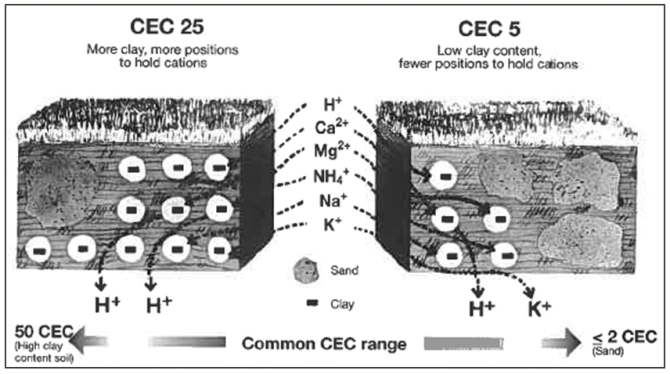Cation Exchange Capacity (CEC) measures the number of negatively charged sites there are in the soil for positive cations to bind to. This helps to hold nutrition in the soil and prevents nutrients from leaching out through the drains. These positive Cations include Calcium (Ca), Potassium (K), Magnesium (Mg), Sodium (Na), and of course Hydrogen (H). A higher CEC means more nutrients that can be held within the root zone without the risk of leaching out through the drains.
The negatively charged particles in soil are found in clay and humus which are usually lacking in high sand rootzones. The CEC may be increased by encouraging the correct soil microbiology to help thatch to degrade naturally, eventually converting it to stable organic matter (humus), or by adding minerals with a high CEC, such as Zeolite. Collectively, we refer to the negatively charged sites on clay and humus particles as the soil colloid.
CEC is measured in meq/100gm, which means milli-equivalents per 100 grams of soil. The relative number of positive charges for any nutrient ion will dictate how strongly it is held on the soil colloid and consequently, how easy or difficult it is to dislodge. For example the Sodium (Na) Ion is defined as Na+, a Calcium ion is Ca++ and one of the common Iron ions is Fe+++ and so on. The plus signs explain the number of missing electrons in the outer shell of the atom which are analogous with the number of charges it has available for bonding with other elements. Sodium (Na+) has one, Calcium (Ca++) has 2 and Iron (Fe+++) has three. In practice this means that 1 Iron ion will take up as much space as 3 Sodium ions on the soil colloid; its 3 plusses (+) occupy 3 negative (-) exchange sites on the available clay or humus.
New build, high sand rootzones usually have a low CEC (typically below 2 meq 100/gm), whereas the rootzone of your green would ideally have a CEC above 7 meq/100gm for efficient nutrient retention, but even that is low compared to more soily (my own scientific term:) soils.

